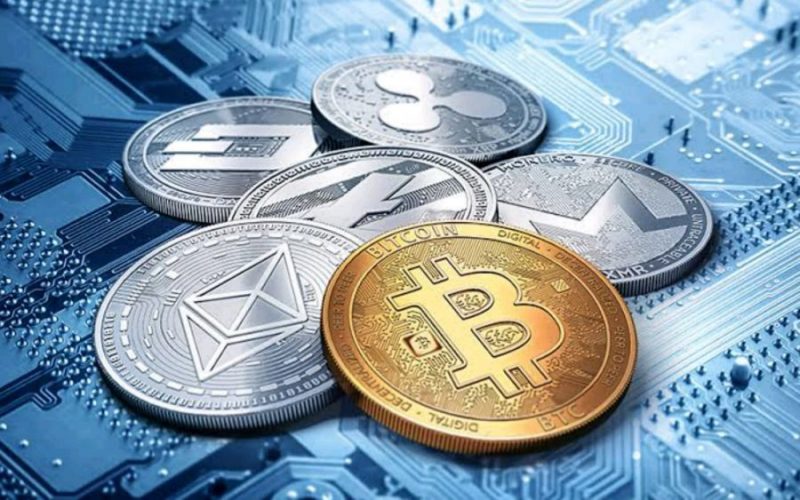Investors trying to diversify their portfolios are flocking to the leading cryptocurrencies. Many developing businesses are already accepting cryptocurrencies as valid payment methods, making today an excellent moment to invest in cryptocurrencies. This post will provide you with a list of the top fastest-growing cryptocurrency.
What Are Cryptocurrencies?
Before we go into some of these Bitcoin alternatives, let’s take a step back and define what we mean by terminologies like cryptocurrency and altcoin. A cryptocurrency, in its broadest sense, is a sort of virtual or digital money in the form of tokens or “coins.” While some cryptocurrencies have entered the physical world through credit cards or other schemes, the vast majority of cryptocurrencies remain completely intangible.
The term “crypto” refers to the complex encryption that enables the creation and processing of digital currency as well as its transactions across decentralized platforms. A common commitment to decentralization goes hand in hand with this crucial “crypto” element of these currencies; cryptocurrencies are often coded by teams who build in methods for issuance (often, but not always, through a process “mine”) and other regulations.
Fastest growing cryptocurrency are almost usually meant to be free of government manipulation and control, yet this fundamental component of the business has come under question as it has risen in popularity. Altcoins, or “shitcoins,” are cryptocurrencies fashioned after Bitcoin that have frequently attempted to promote themselves as improved or modified versions of Bitcoin. While some of these currencies may have certain unique qualities that Bitcoin does not, no altcoin has yet to meet the level of security that Bitcoin’s networks achieve.
Types of Crypto
The fastest-growing cryptocurrency is designed to be used for payments and to transport value (similar to digital money) across a decentralized network of users. Many cryptocurrencies (not Bitcoin or occasionally Ether) are in this fashion and are sometimes to as value tokens.
There are other blockchain-based tokens that aren’t supposed to be used in the same way that money is. A token sold as part of an initial coin offering (ICO) that represents a stake in a blockchain or defi project is one example. Security tokens are those whose value is connected to the worth of the firm or project (as in securities like stocks, not safety).
Other tokens serve a specific purpose, such as Storj tokens, which allow anyone to share files over a decentralized network, or Namecoin, which provides a decentralized DNS service for internet addresses. Utility tokens are what they’re called.
While many crypto users are aware of and appreciate these distinctions, traders and lay investors may be unaware of them because all types of tokens tend to trade in the same way on crypto exchanges.
Fastest Growing Cryptocurrency
#1. Bitcoin (BTC)
Market cap: Over US$327.2 billion
The king of all the fastest-growing cryptos, Bitcoin, started in 2009 and is the first cryptocurrency of its kind to have the largest liquidity value. Similarly, this cryptocurrency aspires to be a complete, global, peer-to-peer digital Fastest growing cryptocurrency with no restrictions. Despite the market’s volatility, Bitcoin remains the most stable. Bitcoin’s popularity, demand, and usage are likely to skyrocket in the coming years, despite the fact that the word is synonymous with the fastest-growing cryptocurrency. Companies are already embracing the concept of accepting bitcoins as payment, paving the way for the future.
Bitcoin’s value has soared as it has grown in popularity. Bitcoin used to cost around $500 when it was first released five years ago. As of the 13th of December 2022, the price of a single bitcoin was around $17,304. That amounts to a rise of 3,304%.
#2. Ethereum (ETH)
Market cap: Over US$169 billion
Ethereum was the first Fastest growing cryptocurrency to feature smart contracts, which allow developers to create decentralized applications using blockchain technology on desktop and mobile devices. Since then, Ethereum has remained among the top cryptocurrencies of all time, and it has a devoted following of investors who back it up. After Bitcoins, this indicates Ethereum has a higher chance of keeping stable.
Ethereum has also exploded in popularity. Its price increased by about 11,336 percent in just over five years, from around US$11 to over US$1,258.
#3. Tether (USDT)
Market cap: Over US$67.9 billion
Tether (USDT) is one of the oldest and most widely used cryptocurrencies that attempts to limit price volatility by being pegged to a fiat currency or some other external reference point. Tether and other stablecoins aim to reduce the wild price swings that have plagued most digital currencies, even the most well-known ones like Bitcoin, in the hopes of attracting those who are wary of the market. It is a digital currency whose value is pegged to the dollar. Users may quickly and conveniently transfer funds between other cryptocurrencies and USD without having to convert to fiat cash.
Tether was released in 2014 with the goal of simplifying the digital use of fiat currencies through the use of blockchain technology.
This digital currency effectively allows people to use a blockchain network and related technologies to transact in fiat currencies while mitigating the usual complexity and volatility of digital currency transactions.
As of the end of 2022, Tether has a market cap of $67.9 billion and a token value of $1.00, making it the third largest cryptocurrency by market cap.
#4. Binance Coin (BNB)
Market cap: Over US$46. 2 billion
Binance Coin (BNB) is a type of cryptocurrency that may be used to trade on Binance, one of the largest cryptocurrency exchanges in the world, as well as pay fees associated with trading. Binance Coin has gone beyond its initial purpose of facilitating trades on the Binance exchange platform since it was first introduced in 2017. Trading, the processing of payments, and even making trip reservations are now all possible uses for the platform. Additionally, it may be bought, sold, or otherwise transacted for other cryptocurrencies, such as Ethereum or Bitcoin, via trading or exchange.
In 2017, BNB traded at a price of only $0.10. Its price has increased to approximately $289 by the end of December 2022, representing a gain of approximately 288,900%.
#5. USD Coin (USDC)
Market cap: Over US$43.3 billion
Another stablecoin, known as USD Coin, fixes its value to that of the United States dollar through the use of fiat-collateralized reserves. This indicates that the company keeps a quantity of fiat currency that is equivalent to the amount of USD Coin that is currently in circulation.
Circle and Coinbase are both members of the Centre Consortium, which is responsible for the introduction of USD Coin in 2018. The fact that Circle is located in the United States means that it is subject to regulation, and as a result, USD Coin is considered to be a regulated stablecoin.
As of the Dec, 2022, the market capitalization of USD Coin is $43.3 billion, and the price per coin is $1.00. It had the fourth highest market valuation and the fifth highest trading volume.
#6. XRP (XRP)
Market cap: Over US$19.6 billion
Ripple, the company that developed the XRP Ledger in 2012 as a payment system, uses XRP as the native coin for the ledger. The XRP Ledger makes use of a consensus method known as the XRP Ledger Consensus Protocol. This protocol does not rely on proof-of-work or proof-of-stake in order to arrive at a decision or validate transactions. In its place, client applications are responsible for signing and transmitting transactions to the ledger servers. After comparing the transactions, the servers come to the conclusion that the transactions are qualified candidates for admission into the ledger.
The transaction candidates are then forwarded by the servers to the validators, who work to verify that the servers have correctly interpreted the transactions before recording the ledger version.
As of Dec, 2022, the value of XRP on the market was approximately $0.39 and it had a market cap of $19.6 billion.
#7. Cardano (ADA)
Market cap: Over US$15.9 billion
Using a research-based methodology, engineers, mathematicians, and cryptography specialists developed Cardano (ADA), a cryptocurrency that uses the “Ouroboros proof-of-stake” system. Charles Hoskinson, one of Ethereum’s five original founders, is also a co-founder of this venture. He quit Ethereum because he didn’t agree with its course and went on to help build Cardano.
The Cardano team built their blockchain after conducting many experiments and reviewing relevant academic literature. The project’s researchers have published over 120 papers on various aspects of blockchain technology. The foundation of Cardano rests on this study.
Cardano is distinguished from other famous cryptocurrencies and other Proof-of-Stake (PoS) coins by virtue of this stringent process. Cardano has been called a “Ethereum killer” due to the belief that its blockchain has greater potential. Although, Cardano is still in its infancy. There is still a ways to go before it can compete with Ethereum in terms of DeFi applications, despite the fact that it adopted the PoS consensus methodology before Ethereum.
By developing Ethereum-like DeFi products and addressing issues like chain interoperability, voter fraud, and legal contract tracing, Cardano plans to become the de facto global financial operating system. The market value of Cardano as of the 13th of December 2022 was $15.9 billion, making it one of the largest. One ADA token was trading at about $0.32.
#8. Dogecoin (DOGE)
Market cap: Over US$13.39 billion
In 2021, the price of Dogecoin (DOGE), which was considered by some to be the first “memecoin,” generated a commotion when it surged. The Shiba Inu serves as the avatar for the coin, which is recognized as a valid form of payment by a number of the world’s most successful businesses.
Dogecoin was initially developed in 2013 by two software programmers by the names of Billy Markus and Jackson Palmer. Reportedly, Markus and Palmer came up with the coin as a joke in order to comment on the irrational speculation that surrounds the cryptocurrency market.
Dogecoin was the 10th largest cryptocurrency by market capitalization as of December 2022, when it had a value of approximately $0.06 per DOGE and had a market capitalization of $13.39 billion.
#9. Solana (SOL)c
Market cap: Over US$11.5 billion
Solana is a blockchain platform launched in 2017 that aims to facilitate DApps (dApps). Solana is sometimes called a “Ethereum killer” due to its ability to process a higher volume of transactions in a given time period. As an added bonus, its transaction fees are lower than Ethereum’s.
Decentralized financial (DeFi) and non-fungible tokens are two examples of cutting-edge applications that can make use of smart contracts, which can be implemented on both Solana and Ethereum (NFTs).
Solana is the name of the digital money powered by the Solana blockchain (SOL). Its cost has increased dramatically ever since it was first introduced. By the end of 2022, the market capitalization of Solana had reached $11.5 billion, and its price had risen to roughly $13.58. This made it the eighth largest cryptocurrency by market cap.
#10. Polkadot (DOT)
Market cap: Over US$7.5 billion
Polkadot (DOT) is a unique PoS cryptocurrency aimed at delivering interoperability among other blockchains. Its protocol is designed to connect permissioned and permissionless blockchains and oracles to allow systems to work together under one roof. Polkadot’s core component is its relay chain, which enables the interoperability of varying networks. It also provides for parachains parallel blockchains with their own native tokens for specific-use cases.21
Where Polkadot differs from Ethereum is that rather than creating just dApps on Polkadot, developers can create their own blockchain while also using the security that Polkadot’s chain already has. With Ethereum, developers can create new blockchains but need to create their own security measures, which can leave new and smaller projects open to attack because the larger a blockchain, the more security it has. This concept in Polkadot is known as shared security.
Polkadot was created by Gavin Wood, another member of the core founders of the Ethereum project who had differing opinions about the project’s future. As of Dec 13th, 2022, Polkadot had a market capitalization of roughly $7.5 billion, and one DOT traded for $5.14.
Why Are Cryptocurrencies Important?
Individuals are able to engage in peer-to-peer financial transactions or enter into contracts using blockchain-based cryptocurrencies since these digital assets function as decentralized platforms. In either scenario, there is no requirement for a reliable third-party intermediary such as a bank, monetary authority, court, or judge to handle the transaction. This has the potential to shake up the existing financial system and make finance more accessible to the general public. Over the course of the last ten years, the scope of the cryptocurrency industry has expanded at an exponential rate, seeing new inventions and amassing a total market valuation of more over $952 billion.
Why is Bitcoin Valuable?
The fact that there are so few Bitcoins in circulation contributes to its high value. There will never be more than 21 million Bitcoins available for purchase. There are currently 19 million different coins available for purchase.
Cryptocurrency miners are rewarded with a certain amount of Bitcoin so that a supply can be created. (The actual amount of Bitcoin that is issued to a miner after successfully mining a single block is 6.25 Bitcoin.) The rewards that are given out for mining Bitcoin are halved about every four years in order to maintain control over the process.
Why Are There So Many Cryptocurrencies?
The majority of cryptocurrencies in circulation today are developed, in one way or another, from Bitcoin, which is the first cryptocurrency to employ open-source technology and a design that is resistant to censorship. This indicates that anyone can copy the code, make modifications to it, and create their own unique cryptocurrency.
Are There Cryptocurrency Exchange-Traded Funds (ETFs)?
It is understandable that you might want to take a diversified approach to investing in cryptocurrency in order to reduce the likelihood of incurring a financial loss. There are thousands of different cryptocurrencies currently in circulation, and the majority of them are characterized by high levels of volatility.
Cryptocurrency exchange-traded funds (ETFs) have been proposed by a number of organizations, including Fidelity; however, regulatory obstacles have hampered the development of any consumer products. As of June 2021, the market does not offer any exchange-traded funds (ETFs) that are accessible to ordinary investors.
10 Important Cryptocurrencies Other Than Bitcoin
#1. Ethereum (ETH)
Ethereum, the first Bitcoin alternative on our list, is a software platform that allows smart contracts and applications (apps) to be and without the need for third-party downtime, fraud, control, or intervention. Ethereum’s goal is to establish a decentralized suite of financial goods that anybody in the world, regardless of nationality, ethnicity, or beliefs, can freely access. 2 This element heightens the ramifications for those in some countries, as those without access to governmental infrastructure and identity can obtain bank accounts, loans, insurance, and a number of other financial items.
Ethereum applications are powered by ether, the platform’s proprietary cryptographic token. Ether serves as a mode of transportation on the Ethereum network, and it is mostly sought by developers who want to build and run apps on the platform as well as investors who want to buy other digital currencies with ether. Ether, which started in 2015, is the second-largest digital Fastest growing cryptocurrency by market value behind Bitcoin however, it is still a long way behind the dominating cryptocurrency. Additionally, ether’s market valuation is less than half that of Bitcoin, trading at roughly $1,258 per ETH as of 13th December 2022.
#2. Litecoin (LTC)
Litecoin, which debuted in 2011, was one of the first cryptocurrencies to follow in Bitcoin’s footsteps, and has been dubbed the “silver to Bitcoin’s gold.” 7 Charlie Lee, a former Google engineer and MIT graduate, designed it. Also, Litecoin is based on an open-source global payment network that is not centralized and employs “scrypt” as a proof of work that can be decoded with consumer-grade CPUs.
Although Litecoin is similar to Bitcoin in many ways, it has a quicker block creation rate and, thus, a faster confirmation time for transactions. A growing number of retailers, in addition to developers, accept Litecoin. Litecoin has a market capitalization of $5.49 billion and a per-token value of roughly $76 as of December 13th, 2022, making it the world’s seventeenth-largest cryptocurrency.
#3. Cardano (ADA)
Cardano is an “Ouroboros proof-of-stake” cryptocurrency by engineers, mathematicians, and cryptography professionals using a research-based approach. 9 Charles Hoskinson, one of Ethereum’s five original founding members, was a co-founder of the project. After some differences with Ethereum’s direction, he quit and later assisted in the creation of Cardano.
Cardano’s blockchain was developed through considerable testing and peer-reviewed research by the Cardano team. The project’s researchers have authored over 90 papers on blockchain technology covering a wide range of issues. 10 Cardano’s research is its foundation.
Cardano appears to stand out among its proof-of-stake peers as well as other significant cryptocurrencies due to this stringent approach. Cardano has also been the “Ethereum killer” because of its blockchain capabilities. Also, 11 Cardano, on the other hand, is still in its infancy. While it has beaten Ethereum to the consensus concept of proof-of-stake, it still has a long way to go in terms of decentralized financial applications.
Cardano aspires to be the world’s financial operating system by creating financial products akin to Ethereum and delivering solutions for chain interoperability, voter fraud, and legal contract tracing, among other things. Cardano has a market capitalization of $10.73 billion as of December 13th, 2022, and one ADA currently trades for roughly $0.307.
#4. Polkadot (DOT)
Polkadot is a one-of-a-kind proof-of-stake coin that aims to provide interoperability between different blockchains. Its protocol connects permissioned and permissionless blockchains, as well as oracles, allowing systems to collaborate under one roof. Polkadot’s essential component is its relay chain, which enables network interoperability. For specific use scenarios, it also allows for “parachains,” or alternative blockchains with their own native currency. 12
Polkadot differs from Ethereum in that instead of constructing just decentralized applications on the platform. Developers can establish their own blockchain while still benefiting from the security provided by Polkadot’s chain. Developers can establish new blockchains with Ethereum, but they must implement their own security mechanisms, which could expose new and smaller projects to attack, as the larger a blockchain is, the more secure it is. Polkadot refers to this concept as “shared security.”
Gavin Wood, another of the Ethereum project’s main founders who had conflicting perspectives on the project’s future, launched Polkadot. Polkadot has a market valuation of $6.06 billion as of December 13th 2022, and one DOT is worth $5.14.
#5. Bitcoin Cash (BCH)
Because it is one of the earliest and most successful hard forks of the original Bitcoin. Bitcoin Cash (BCH) occupies a significant place in the history of altcoins. A split occurs in the bitcoin sector as a result of disagreements and debates between developers and miners because of the decentralized nature of digital currencies. Substantial changes to the code underpinning the token or coin in question require widespread consensus; the mechanism for this process varies for every cryptocurrency.
When rival groups cannot agree, the digital currency is shared, with the original chain remaining true to its original code and the new chain starting off as a new version of the previous coin, replete with code alterations.
As a result of one of these splits, BCH was born in August 2017. The discussion that led to the formation of BCH revolved over scalability; the Bitcoin network has a block size restriction of one megabyte (MB). The block size in BCH is from one MB to eight MBs, with the concept that larger blocks can carry more transactions, resulting in faster transaction speeds. 14 Other changes include the removal of the Segregated Witness protocol, which has an effect on block space. BCH has a market capitalization of roughly $2.10 billion and a value per coin of $108 as of December 13th, 2022.
#6. Stellar (XLM)
Stellar is an open blockchain network that connects financial institutions for the purpose of massive transactions to give enterprise solutions. Huge transactions between banks and investment firms, which used to take several days, involved a number of intermediaries, and cost a lot of money. May now be almost instantly with no intermediaries and for a fraction of the cost.
Despite its positioning as an enterprise blockchain for institutional transactions, Stellar is still an open blockchain that anybody can utilize. Cross-border transactions in any currency are possible with this system. Lumens are Stellar’s native currency (XLM). 16 For users to be able to transact on the network, they must have Lumens.
Jed McCaleb, a founding member of Ripple Labs and the creator of the Ripple protocol, launched Stellarly. He subsequently left Ripple and went on to form the Stellar Development Foundation with his co-founders. 17 As of 13th December 2022, Stellar Lumens has a market capitalization of $2.15 billion and are at $0.08.
#7. Dogecoin (DOGE)
The price of Dogecoin, dubbed the “original meme coin” by some, surged in 2021, causing a commotion. In addition, the coin, which has a Shiba Inu as its avatar, is a means of payment by a number of big businesses, including the Dallas Mavericks, Kronos, and, perhaps most importantly, SpaceX, Elon Musk’s American aerospace company.
Billy Markus and Jackson Palmer, two software programmers, founded Dogecoin in 2013. In fact, Markus and Palmer are said to have the coin as a prank in response to the cryptocurrency market’s rampant speculation.
During the week that Elon Musk was set to appear on Saturday Night Live, the price of DOGE reached an all-time high of $0.71. Dogecoin has a market valuation of $12.34 billion as of December 13th 2022, and one DOGE is worth roughly $0.08, making it the tenth-largest cryptocurrency.
#8. Binance Coin (BNB)
Binance Coin is a utility cryptocurrency that may be used to pay for trading costs on the Binance Exchange. Similarly, by market capitalization, it is the third-largest cryptocurrency. Those who use the token to pay for the exchange can trade at a reduced rate. The Binance Coin blockchain also serves as the foundation for Binance’s decentralized exchange. Changpeng Zhao launched the Binance exchange which is one of the most popular in the world in terms of trading volume.
Binance Coin was first released as an ERC-20 token on the Ethereum platform. It was subsequently given its own mainnet. A proof-of-stake consensus model is used by the network. Binance Coin has a market capitalization of $43.60 billion as of 13th December 2022, making one BNB worth $267.
#9. Tether (USDT)
Tether was one of the first and most popular of a class of cryptocurrencies known as stablecoins. which try to decrease volatility by pegging their market value to a currency or other external reference point. Similarly, tether and other stablecoins seek to smooth out price variations to attract consumers who might otherwise be wary of digital currencies. Especially significant ones like Bitcoin, which have suffered repeated bouts of severe volatility. The price of Tether is directly related to the price of the US dollar. However, the method enables users to make transfers from other cryptocurrencies to US dollars in a fraction of the time it takes to convert to regular currency.
Tether, which was founded in 2014, defines itself as a “blockchain-enabled platform meant to simplify the digital use of fiat currencies.”
21 This coin effectively allows individuals to transact in traditional currencies using a blockchain network and related technologies while avoiding the volatility and complexity frequently associated with digital currencies. More so, the tether is the fifth most valuable cryptocurrency by market capitalization as of December 13th, 2022, with a total market worth of $67.9 billion and a per token value of (you guessed it!) $1.
#10. Monero (XMR)
Monero is a safe, anonymous, and untraceable cryptocurrency. Consequently, this open-source cryptocurrency was first released in April 2014, and it quickly gained popularity among cryptography aficionados. Furthermore, the development of this coin is entirely funded by donations and driven by the community. Monero was created with a heavy focus on decentralization and scalability, and it uses a technology called “ring signatures” to provide perfect secrecy.
With this method, a group of cryptographic signatures appears, at least one of which is genuine. But the genuine one cannot be because they all appear to be authentic. Monero has gained a shady reputation as a result of its extraordinary security systems, and it has been tied to illicit enterprises all over the world. 25 Monero is a good candidate for anonymous illicit transactions. The secrecy it provides is also beneficial to dissidents in authoritarian countries around the world. Monero has a market capitalization of $2.72 billion and a per-token value of $149 as of December 13th, 2022.
How Does Trading Cryptocurrencies Differ from Trading Stocks?
Although it is possible to invest in cryptocurrencies, doing so is very different from traditional forms of investment like as buying stocks. When you purchase stock in a firm, you are actually purchasing a piece of ownership in that company. Because of this, purchasing stock grants you certain rights, such as the ability to vote on important business decisions. If that company declares bankruptcy, you may be eligible for some form of compensation after its debtors have been paid from the proceeds of the sale of its assets.
The purchase of cryptocurrencies does not confer ownership over anything other than the token itself; rather, it is analogous to swapping one form of currency for another. In the event that the value of the cryptocurrency drops, you won’t receive anything after the fact.
Do You Have to Pay Taxes on Cryptocurrency?
Paying attention to the regulations governing taxes on cryptocurrencies is essential if you acquire and sell coins. Instead of being handled like cash, cryptocurrencies are classified as capital assets, similar to stocks. This means that if you sell bitcoin and make a profit, you will be responsible for paying taxes on the capital gain. Even if you make a purchase using cryptocurrency as payment, this will still be the case. If you sell it for more than you paid for it, you will be responsible for paying taxes on the difference in value.
Which Crypto Will Make You Rich in 2025?
- Bitcoin (BTC)
Bitcoin (BTC-USD) has been the digital currency industry’s benchmark for well over a decade, ever since its introduction. This makes it the gold standard. It is surprising that Bitcoin has become an investment vehicle; a considerable number of institutional investors have welcomed BTC with open arms and are spending significant amounts of money into it.
FAQ
What is the most popular cryptocurrency 2022?
1. Bitcoin. There’s absolutely no surprise whatsoever that Bitcoin (CRYPTO: BTC) still reigns as the world’s most popular cryptocurrency. Its market cap currently stands at nearly $1.1 trillion.
Can you mine litecoin?
Today, Litecoin cannot be mined efficiently with CPU or GPU graphic cards anymore. In order to competitively mine Litcoin, so-called application-specific integrated (ASIC) mining machines are needed. These ASIC mining processors have been uniquely designed to mine Litecoin.
Is it good to invest in Tron coin?
What makes TRON cryptocurrency a good buy? Backed by blockchain technology, the TRON cryptocurrency has the functionality which enables it to host multiple decentralized applications. Also, its future potential of leading the Web 3.0 referred to above as well as its affordable pricing makes it a good buy.






